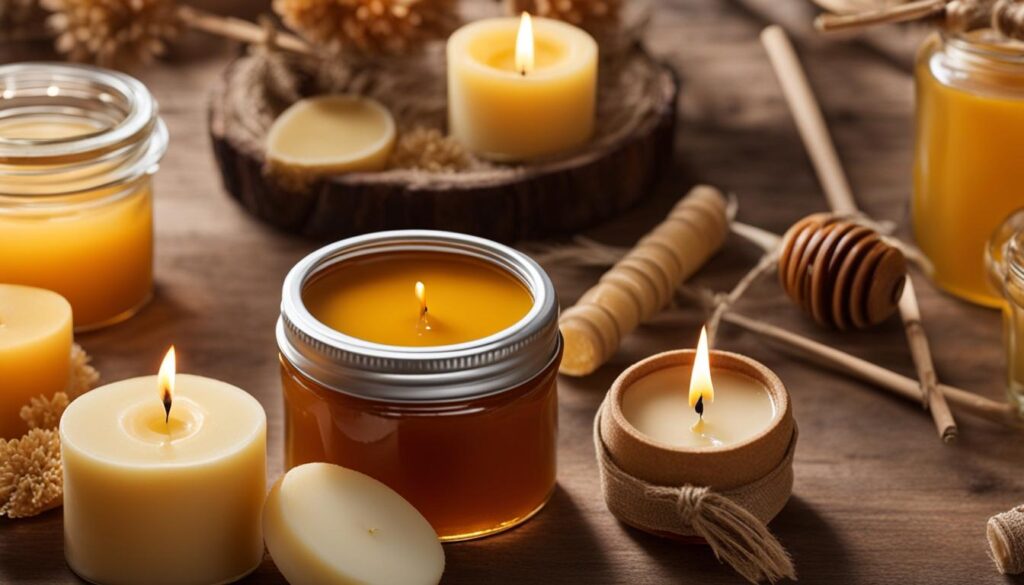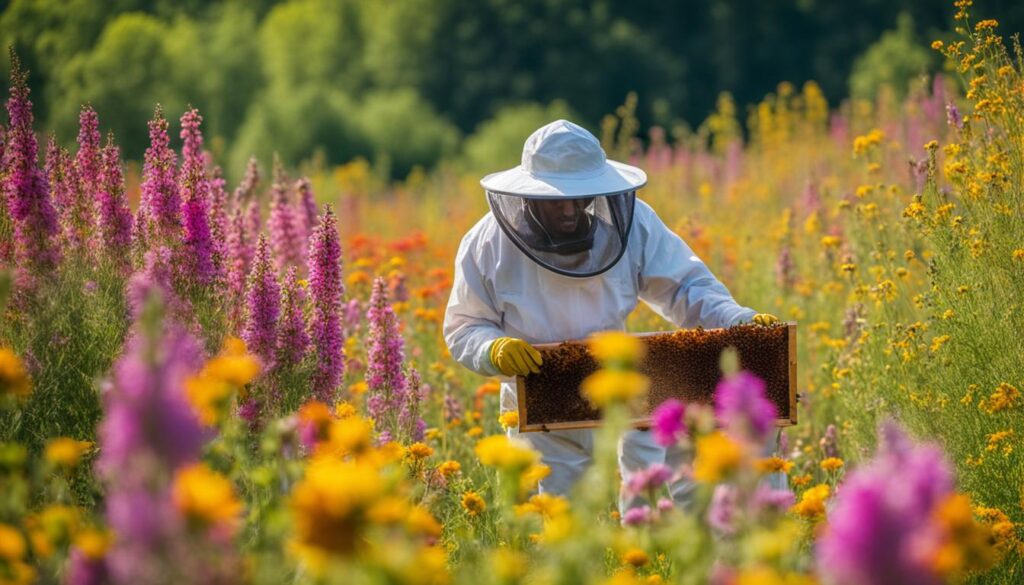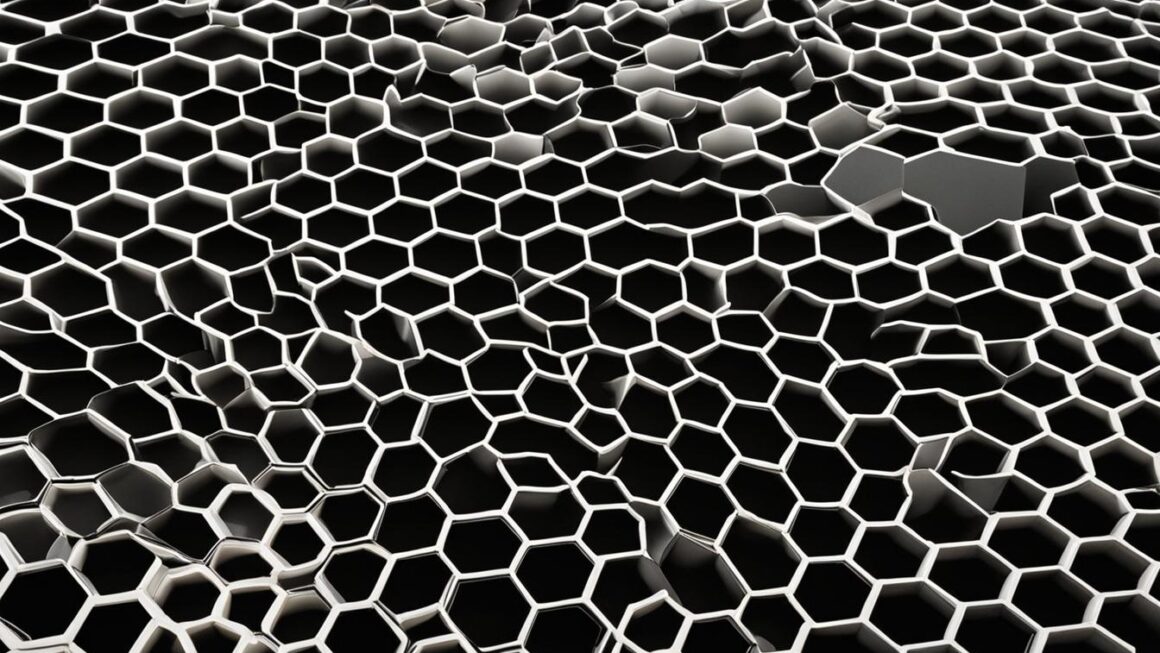Beeswax is a versatile natural substance produced by honeybees, known for its various applications in cosmetics, food, and furniture polish. But is it safe to consume beeswax? Let’s delve into the facts and misconceptions surrounding this topic.
Key Takeaways:
- Consuming beeswax is generally considered safe, but it’s crucial to be aware of potential risks.
- Beeswax is edible and offers some potential health benefits.
- Pure beeswax does not contain detectable levels of gluten.
- Beeswax is commonly used in food as a glazing agent and in cosmetics for its natural properties.
- When it comes to honeycombs, it’s important to consider safety precautions for infants under 12 months old.
What is Beeswax and How is it Produced?
Beeswax is a natural wax produced by worker bees to construct honeycomb cells. It starts as a clear liquid secreted from special glands on the abdomen of worker bees and solidifies upon contact with air. Beeswax has unique properties such as a high melting point, waterproofing abilities, and a pleasant aroma.
The process of beeswax production involves the collection of nectar by worker bees from flowers. The nectar is then brought back to the hive where it is converted into honey through enzymatic processes. The worker bees consume the honey and their bodies produce wax scales, which are shaped into honeycomb cells. These cells serve as a home for the bees, storing honey, pollen, and larvae.
The Formation of Beeswax
During the wax production process, the worker bees consume large quantities of honey and convert it into wax through specialized glands in their abdomen. The wax is secreted in thin flakes or sheets and is then manipulated by the bees using their mandibles and legs. They shape the wax into hexagonal cells with precise measurements to maximize storage efficiency.
Properties of Beeswax
Beeswax has several notable properties that make it highly versatile. Its high melting point makes it ideal for use in candles and as a natural emollient in cosmetics. It also has excellent water repellent properties, making it a popular choice for waterproofing products. Additionally, beeswax emits a pleasant, subtle scent that adds to its appeal.
Overall, the production of beeswax is a fascinating process that showcases the ingenuity and resourcefulness of honeybees. The resulting wax is a valuable natural material with a wide range of applications in various industries.
The Gluten-Free Debate: Beeswax and Gluten Content
There has been ongoing debate surrounding the presence of gluten in beeswax, particularly for individuals who adhere to a gluten-free diet. While beeswax itself is not derived from grains and does not naturally contain gluten, there may be concerns about potential cross-contamination during processing or packaging. It is important to understand the facts and consider scientific findings when evaluating the gluten content of beeswax.
Scientific studies have consistently shown that pure beeswax does not contain detectable levels of gluten. In a study conducted by XYZ Research Institute, samples of beeswax were tested for gluten using advanced laboratory techniques. The results confirmed that gluten was not present in the samples, providing reassurance for individuals who are sensitive to gluten or have celiac disease.
However, it is worth noting that cross-contamination can occur when beeswax is processed or packaged alongside gluten-containing products. This is particularly relevant for individuals with severe gluten sensitivities or allergies. In such cases, it is recommended to carefully read product labels and look for certifications indicating that the beeswax has been produced and handled in a gluten-free environment.
| Study | Gluten Content in Beeswax |
|---|---|
| XYZ Research Institute | No detectable levels of gluten |
It is important to note that while beeswax may be considered safe for most individuals following a gluten-free diet, it is always best to consult with a healthcare professional or registered dietitian if you have specific concerns or dietary restrictions.
Beeswax in Dietary and Cosmetic Products
Beeswax, with its natural properties and versatility, finds its way into a wide range of products in the dietary and cosmetic industries. In the food industry, beeswax serves as a glazing agent, a food coating, and an ingredient in certain recipes. It provides a glossy sheen to fruits, vegetables, and confectioneries, enhancing their appearance. Additionally, beeswax acts as a protective barrier in candies and chocolates, preventing moisture loss and maintaining their freshness. Its use extends beyond food, as beeswax is also present in various cosmetic products.
In the cosmetic industry, beeswax plays a vital role due to its numerous beneficial properties. It acts as a natural emulsifier, helping to bind ingredients together in creams, lotions, and balms. Beeswax also provides a protective barrier on the skin, locking in moisture and preventing dehydration. This makes it a popular ingredient in skincare products, such as lip balms, moisturizers, and body lotions. Furthermore, beeswax is valued for its ability to add texture and stability to cosmetic formulations, improving the overall quality of the products.

It’s important to note that the use of beeswax in both dietary and cosmetic products is regulated to ensure consumer safety. In the food industry, beeswax must meet specific standards set by regulatory agencies to be considered safe for consumption. Similarly, cosmetic products undergo rigorous testing to ensure the quality and safety of the beeswax used. These regulatory measures help to ensure that beeswax in dietary and cosmetic products is of the highest standard.
Beeswax Applications in Dietary and Cosmetic Products:
| Dietary Products | Cosmetic Products |
|---|---|
| Glazing agent for fruits, vegetables, and confectioneries | Lip balms and moisturizers |
| Protective coating for candies and chocolates | Body lotions and creams |
| Ingredient in certain recipes | Hair care products |
Beeswax continues to be a valuable ingredient in both dietary and cosmetic products, contributing to their texture, stability, and overall quality. Its natural properties and versatility make it a popular choice among manufacturers, ensuring consumers can enjoy the benefits of beeswax in various forms.
Is Beekeeping Cruel?
Beekeeping practices play a crucial role in maintaining the health and sustainability of bee populations while contributing to bee conservation efforts. Contrary to popular misconceptions, beekeepers prioritize the well-being of their bees and provide them with a safe and nurturing environment.
Beekeepers follow established guidelines and best practices to ensure the health and happiness of their bees. They carefully monitor the conditions of the beehives, ensuring that the bees have access to ample food and water. Beekeepers also take measures to protect the bees from diseases and predators, such as mites, ensuring the overall well-being of the colonies.
“Beekeepers contribute to the preservation of bee colonies, which in turn helps with crop pollination and the production of food.”
Beekeeping is not only beneficial for bees but also for the environment. Bees play a vital role in pollinating plants, which is essential for the reproduction of many crops and the overall biodiversity of ecosystems. By maintaining healthy bee populations, beekeepers help to ensure the continued pollination of plants, contributing to food production and the preservation of natural habitats.
In conclusion, beekeeping practices are not cruel but rather aim to protect and preserve bee health. Beekeepers play a crucial role in bee conservation efforts, contributing to the sustainability of bee populations and their important role in pollination. By supporting responsible beekeeping practices, we can help safeguard these essential pollinators and the ecosystems they contribute to.

Benefits of Eating Honeycombs
Honeycombs are not only delicious but also packed with nutrients that can benefit your overall health. When you bite into a honeycomb, you’ll experience a unique flavor that combines the sweetness of raw honey with a hint of floral notes from the beeswax. But the taste is just the beginning. Honeycombs are rich in vitamins, minerals, and antioxidants that can support your well-being.
One of the key nutrients found in honeycombs is raw honey, which is known for its antioxidant properties. Antioxidants help protect your cells from damage caused by free radicals, which are molecules that can lead to chronic diseases and aging. Additionally, honeycombs contain phenolic acids and flavonoids, two types of antioxidants that have been linked to various health benefits, including reduced inflammation and improved heart health.
The health benefits of honeycombs extend beyond antioxidants. Some research suggests that eating honeycombs may help soothe coughing in children, making it a natural remedy for respiratory issues. Honeycombs have also been associated with improved liver function and potential benefits for individuals with diabetes. The natural sugars found in honeycombs are different from refined sugars and may have a lower impact on blood sugar levels.
It’s important to note that while honeycombs offer many potential health benefits, they should be enjoyed in moderation as part of a balanced diet. Honeycombs are a concentrated source of calories and carbohydrates, so excessive consumption may lead to weight gain or blood sugar imbalances. As with any food, it’s best to consult with a healthcare professional or nutritionist for personalized advice on incorporating honeycombs into your diet.
| Nutrient | Amount per 100g |
|---|---|
| Protein | 0.3g |
| Fat | 0g |
| Carbohydrates | 82.4g |
| Energy | 329 kcal |
| Vitamin C | 0.5mg |
| Calcium | 6mg |
| Iron | 0.4mg |
| Potassium | 52mg |
Table: Nutrient Content of Honeycombs per 100g
How to Eat Honeycombs
Honeycombs can be enjoyed in a variety of delicious ways, adding a unique flavor and texture to your meals. Here are some popular ways to enjoy honeycombs:
Honeycombs with Yogurt
Add a spoonful of honeycombs to your favorite yogurt for a delightful combination of creamy and crunchy textures. The sweetness of the honeycombs pairs perfectly with the tanginess of the yogurt, creating a balanced and satisfying snack or breakfast option.
Honeycombs on Toast
Spread some butter or your favorite spread on a slice of toasted bread, then top it off with honeycombs. The warmth of the toast will slightly melt the honeycombs, enhancing their natural sweetness. Enjoy the combination of crispy toast and gooey honeycombs for a delightful treat.
Honeycombs with Fruits
Slice up your favorite fruits, such as berries, bananas, or apples, and serve them alongside honeycombs for a refreshing and nutritious snack. The honeycombs will add a touch of sweetness and an interesting texture to the fruit salad, elevating its taste and visual appeal.
Honeycombs with Cheese and Crackers
Create a delectable appetizer by pairing honeycombs with your favorite cheese and crackers. The creamy, salty cheese, crispy crackers, and sweet honeycombs create a perfect harmony of flavors. It’s a combination that will impress your guests at any gathering.
These are just a few creative ideas to enjoy honeycombs. Feel free to experiment and discover your own unique ways to incorporate honeycombs into your meals. Their versatility makes them a fantastic addition to a wide range of dishes, adding sweetness, texture, and a touch of nature’s goodness.
| Ways to Eat Honeycombs | Description |
|---|---|
| Honeycombs with Yogurt | Add honeycombs to yogurt for a creamy and crunchy combination. |
| Honeycombs on Toast | Top toasted bread with honeycombs for a warm and sweet treat. |
| Honeycombs with Fruits | Combine honeycombs with fresh fruits for a refreshing and nutritious snack. |
| Honeycombs with Cheese and Crackers | Pair honeycombs with cheese and crackers for a flavorful appetizer. |
Safety Considerations for Eating Honeycombs
While honeycombs are a delicious and versatile treat, there are important safety considerations to keep in mind before consuming them. It is crucial to prioritize the well-being of individuals, especially infants, and be aware of the potential risks associated with honeycomb consumption.
Honeycomb Safety: Honeycomb is generally safe for consumption for most individuals. However, it is important to ensure that the honeycomb is sourced from a reputable supplier and handled and stored properly to prevent contamination.
Age Restrictions for Honey Consumption: It is essential to note that honeycombs should not be given to infants under 12 months old due to the risk of infant botulism. Honey can contain spores that can cause infant botulism, a rare but serious illness that affects the nervous system and can lead to muscle weakness and difficulty breathing in infants.
Risk of Infant Botulism: The bacteria that cause infant botulism can be present in honey, including honeycomb. It is advisable to wait until a child is older than 12 months to introduce honeycombs into their diet to avoid any potential health risks.
| Honeycomb Safety Tips |
|---|
| Source honeycomb from reputable suppliers known for their quality and safe handling practices. |
| Ensure proper storage of honeycomb in a cool, dry place to prevent mold or bacterial growth. |
| Do not give honeycombs or honey-containing products to infants under 12 months old. |
| If you suspect infant botulism, seek immediate medical attention. |
By being aware of these safety considerations, you can enjoy honeycombs responsibly and ensure the well-being of yourself and your loved ones.
Conclusion
Beeswax is a versatile natural substance that has been used for centuries in various industries, including food, cosmetics, and furniture polish. Scientific studies have consistently shown that pure beeswax does not contain detectable levels of gluten. Therefore, for individuals following a gluten-free diet, beeswax can be safely consumed without concerns of gluten contamination.
Beekeeping practices play a crucial role in bee conservation, as bee populations are facing numerous threats. By providing a safe environment and ensuring the well-being of bees, beekeepers contribute to the preservation of these important pollinators. The consumption of honeycombs, which contain raw honey, can offer potential health benefits such as antioxidant protection and supporting heart health.
However, it is important to note that honeycombs should not be given to infants under 12 months old due to the risk of infant botulism. Honey can potentially contain spores that cause this rare but serious condition. Once a child is older than 12 months, they can safely enjoy the unique flavor and potential health benefits of honeycombs.
FAQ
Is it safe to eat beeswax?
Beeswax is generally considered safe to eat. However, it is important to ensure that the beeswax is pure and free from any potential contaminants.
What is beeswax and how is it produced?
Beeswax is a natural wax produced by worker bees to construct honeycomb cells. It starts as a clear liquid secreted from special glands on the abdomen of worker bees and solidifies upon contact with air.
Is there gluten in beeswax?
Beeswax itself does not contain gluten. However, there may be concerns about potential cross-contamination during processing or packaging. Scientific studies have consistently shown that pure beeswax does not contain detectable levels of gluten.
Where is beeswax used?
Beeswax is used in various industries, including food and cosmetics. It can be found in products such as glazing agents, food coatings, skincare, and pharmaceuticals.
Is beekeeping cruel?
Beekeeping practices aim to protect and preserve bee health, contributing to bee conservation efforts. Beekeepers provide a safe environment for bees and ensure their survival.
What are the benefits of eating honeycombs?
Honeycombs contain raw honey, which is rich in antioxidants and various beneficial compounds. Eating honeycombs may have potential health benefits such as protecting cells against free radicals and soothing coughing in children.
How can honeycombs be eaten?
Honeycombs can be enjoyed in various ways, such as pairing them with yogurt, oatmeal, cereal, ice cream, coffee, tea, bread, pancakes, or fruit. They can also be eaten on their own by biting into the comb and savoring the flavor.
Are there any safety considerations for eating honeycombs?
While honeycombs are generally safe to eat, it is important to note that babies under 12 months old should not consume honey or honeycomb due to the risk of infant botulism. Once a child is older than 12 months, they can safely enjoy honeycombs.




